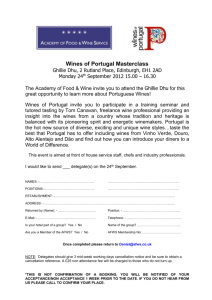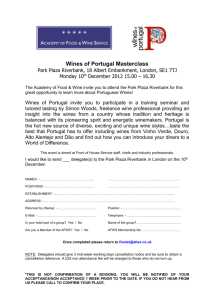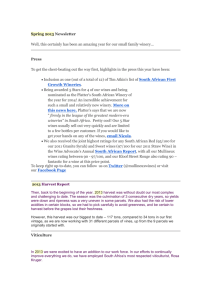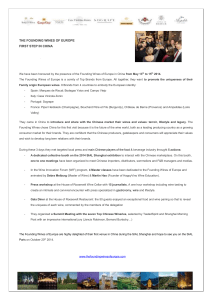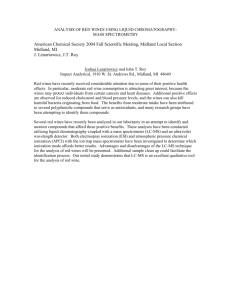DOC - Europa
advertisement
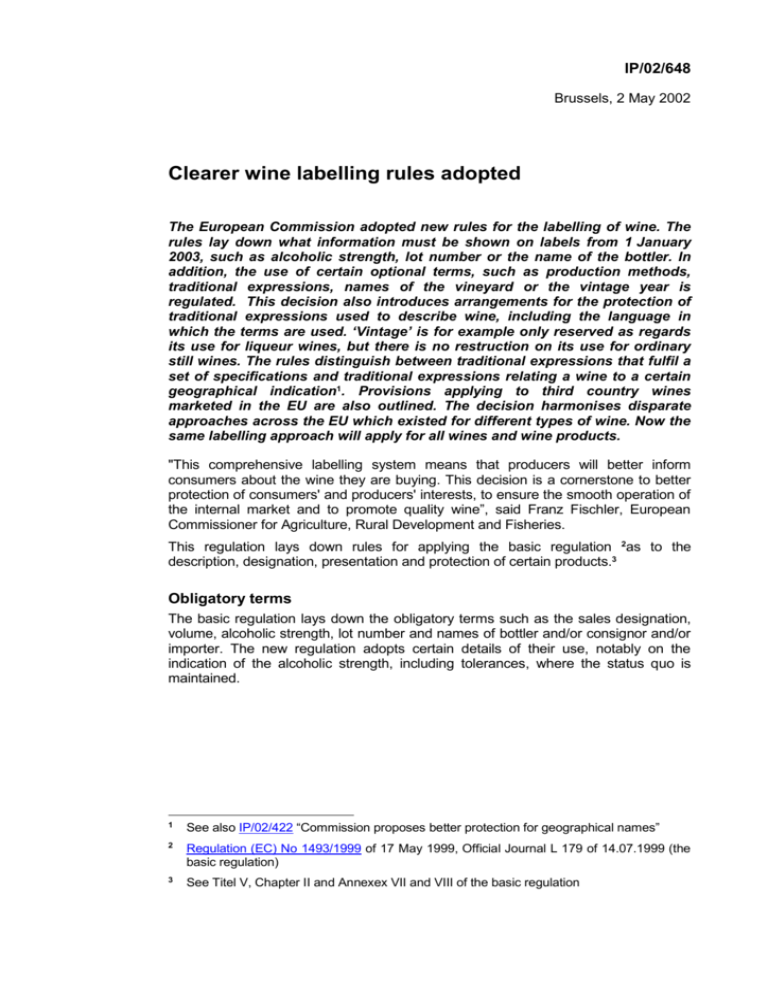
IP/02/648 Brussels, 2 May 2002 Clearer wine labelling rules adopted The European Commission adopted new rules for the labelling of wine. The rules lay down what information must be shown on labels from 1 January 2003, such as alcoholic strength, lot number or the name of the bottler. In addition, the use of certain optional terms, such as production methods, traditional expressions, names of the vineyard or the vintage year is regulated. This decision also introduces arrangements for the protection of traditional expressions used to describe wine, including the language in which the terms are used. ‘Vintage’ is for example only reserved as regards its use for liqueur wines, but there is no restruction on its use for ordinary still wines. The rules distinguish between traditional expressions that fulfil a set of specifications and traditional expressions relating a wine to a certain geographical indication1. Provisions applying to third country wines marketed in the EU are also outlined. The decision harmonises disparate approaches across the EU which existed for different types of wine. Now the same labelling approach will apply for all wines and wine products. "This comprehensive labelling system means that producers will better inform consumers about the wine they are buying. This decision is a cornerstone to better protection of consumers' and producers' interests, to ensure the smooth operation of the internal market and to promote quality wine”, said Franz Fischler, European Commissioner for Agriculture, Rural Development and Fisheries. This regulation lays down rules for applying the basic regulation 2as to the description, designation, presentation and protection of certain products.3 Obligatory terms The basic regulation lays down the obligatory terms such as the sales designation, volume, alcoholic strength, lot number and names of bottler and/or consignor and/or importer. The new regulation adopts certain details of their use, notably on the indication of the alcoholic strength, including tolerances, where the status quo is maintained. 1 See also IP/02/422 “Commission proposes better protection for geographical names” 2 Regulation (EC) No 1493/1999 of 17 May 1999, Official Journal L 179 of 14.07.1999 (the basic regulation) 3 See Titel V, Chapter II and Annexex VII and VIII of the basic regulation Optional but regulated terms Again the basic regulation stipulates these terms. Some terms may be used for all wines, for instance names of those involved in the commercial chain, the type of product (dry, sweet, etc;) and a particular colour beyond the usual red/white/rosé classification. Terms concerning the vintage year, the vine variety, awards and medals, production methods, traditional expressions, names of vineyards and places of bottling are however reserved for wines with a geographical indication. The Commission regulation now lays down the detailed rules concerning the use of these terms. In some cases, it provides for harmonised EU rules. So for the type of product there are binding sugar levels which are applicable equally to all wines, EU wines and imported ones. Responsibility for the regulation of other terms is passed to the country where the wine was produced, whether it concerns an EU Member State or a third country. “Free” terms Terms which do not fall under either the obligatory or optional but regulated categories may be added on the label, providing they do not mislead consumers. Traditional Expressions (TEs) To prevent misuse and in the interests of fair competition, consumer protection and market transparency, traditional expressions4 are reserved for the wines concerned. Some TEs are considered to be so closely linked to a geographical origin as to meet the TRIPs5 definition of a Geographical Indication (GI). Therefore the regulation provides for exclusive protection for these terms subject to the TRIPs disciplines. The new approach on traditional expressions continues to provide protection for Community TEs on the EU market. It also ensures that the protection of TEs is homogenous for all types of wine, based on objective criteria set out in the legislation. The protection only extends to the terms listed in the Annex of the regulation, covers the original language version and so not translations and only extends against use for the type of wine concerned. Hence ‘vintage’ is for example only reserved as regards it use for liqueur wines but not as regards it use for ordinary still wines. Further, there is a saving for all pre-existing trademarks applicable in EU territory. Examples of these traditional expressions are Ruby, Tawny or Vintage for “Port” from Portugal and Amarone for "Valpolicella" or Gutturnio for "Colli Piacentini" or Lacryma Christi for "Vesuvio" from Italy. 4 5 A traditional expression (TE) is a term used to designate wines (which might be a production or ageing method, a colour, a quality etc.) which has three key characteristics : a legislative, simple and precise definition a traditional use (minimum 10 years ) on the EC market and a notoriety in the mind of the consumer resulting from that definition and tradional use The World Trade Organisation (WTO) Agreement on the Trade-Related Aspects of Intellectual Property Rights (TRIPs) requires all WTO Members to respect a comprehensive set of minimum standards of protection for IRPs (Intellectual Property Rights). It also covers their enforcement. 2 Third country wines and Geographical Indications (GIs) In the context of third country wines, the regulation provides national treatment. In this way, third country wines with a GI are treated the same as EU wines with a GI. In terms of the use of the GI, the rules ensure full compliance with our TRIPs obligations. For WTO members GIs may be used if they meet the TRIPs definition. Also the use of homonymous GIs is permitted, in accordance with the TRIPs commitments. Bottle shapes The regulation reserves certain bottle shapes for certain types of wine, such as the German "Bocksbeutel" bottle or the French "Flute d'Alsace". Background As part of the implementation of Agenda 2000, a new common market organisation for wine was established in 1999. The basic regulation aims to maintain a better balance between supply and demand on the Community market, allowing producers to take advantage of expanding markets and enable the sector to become more competitive in the longer term. It applies to fresh grapes other than table grapes, grape juice and musts, wine of fresh grapes (including sparkling wines, liqueur wines and semi-sparkling wines), wine vinegar, piquette, wine lees and grape must. It lays down the principles of the EU wine labelling rules in Title V, Chapter II and in Annexes VII and VIII but leaves a large number of implementing provisions to be adopted by the Commission. The new labelling Commission regulation is the ninth and final implementing regulation, itself repealing and replacing four existing Commission regulations. 3
